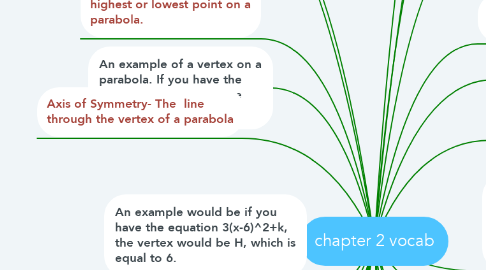chapter 2 vocab
by Sydney Gillespie

1. Parabola- A parabola is the U shaped curve.
2. An example of a Parabola would be X^2
3. Vertex(of a parabola)- the highest or lowest point on a parabola.
4. An example of a vertex on a parabola. If you have the equation 3(x-6)^2+8, the vertex would be (6,8)
5. Axis of Symmetry- The line through the vertex of a parabola
6. An example would be if you have the equation 3(x-6)^2+k, the vertex would be H, which is equal to 6.
7. Trinomial- A polynomial with 3 terms
8. An example of a trinomial would be x^2+5x-4
9. Vertex Form- A quadratic function written in the form A(x-h)^2+k
10. An example of this would be 3(x-7)^2+6
11. Standard Form- A form of linear equation Ax+By=c
12. An example of standard form would be 3x+7y=9
13. Root of an equation- Any value of the variable that makes the equation true
14. An example of a root of an equation would be if the roots are -2 and -3, the equation would have to be (x+2) (x+3) to make the equation true.
15. Minimum value- The value of the vertex when a parabola opens downward.
16. An example of minimum value. If you have a function of 3x^2+2x+1, the minimum would be 2/3.
17. Maximum value- The y value of the vertex when a parabola opens downward
18. An example of maximum value. If you have a function of -2x^2-4x-2. The maximum value would be 0.
19. Quadratic Model- A quadratic function used to represent a set of data
20. An example of a quadratic model would be -16x^2+64x+4
21. Quadratic Regression- A statistical method used to fit a quadratic model to a given set of data.
22. quadratic function- a function written in the form ax^2+bx+c.
23. An example of a quadratic function would be 3x^2-6x+5
24. Completing the square- A process used to form a perfect square trinomial.
25. An example of completing the square would be x^2+4x. To complete the square add (b/2)^2 and you would get (4/2)^2, which equals 4. Then you add four to the equation to get x^2+4x+4.
26. Zero of a function- The value of input that makes the output
27. An example of zero of a function would be the x- intercepts.
28. Quadratic functions have two x intercepts.
29. Imaginary Number- The square root of a negative number, written in the form bi, where b is a real number and i is an imaginary unit.
30. An example of an imaginary number would be 4 times the square root of -25 which would equal 20i.
31. Imaginary Unit- The unit in imaginary number system.
32. An example of the imaginary unit would be the square root of -1.
33. Complex Number- Any number that can be written as a+bi, where a and b are real numbers and i equals the square root of -1.
34. An example of a complex number would be 2+3i.
35. Real Part- For a complex number in the form of a+bi, a is the real part
36. An example of a real part. From the complex number of 4+7i, 4 would be the real part.
37. Imaginary Part- For a complex number in the form of a+bi, b would be the imaginary part.
38. An example of an imaginary part. If you have the equation 2+5i, 5 would be the imaginary part.
39. Complex Conjugate- Two complex numbers that have the same real part and imaginary part but opposite signs.(a+bi) to (a-bi).
40. An example of complex conjugate. The complex conjugate of 2+4i would be 2-4i.
41. Discriminant- The discriminant of the quadratic equation ax^2+bx+c=0 is b^2-4ac
42. An example of discriminant. If you have the equation 3x^2+5x+8, the discriminant would be 3x^2-4(5)(8).


